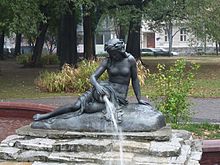Archaeological site "Pionirski Park"
Pionirski Park is an archaeological site in Serbia . Systematic research into the ancient Singidunum has been ongoing since the beginning of the 20th century. The knowledge about this city is still superficial compared to the history of other ancient cities, which have been explored for just as long. One of the reasons for this is that modern Belgrade grew up on the ancient Singidinum, the construction of which destroyed the previous cultural layers.
Archaeological site
The ancient Singidunum, which consisted of an army camp, a civilian settlement and a necropolis, was declared an archaeological site - cultural property - by resolution No. 176/8 of June 30, 1964 of the Institute for the Protection of Monuments of the City of Belgrade. This city was an important urban center of the province of Moesia Superior in the 1st century of our time . Due to its location between the two large cities Sirmium and Viminatium , Singidunum developed as an important link between them. The specific strategic location was a prerequisite for the development of the urban structure of the city, which consisted of a legionary camp, a necropolis and crafts.
The trapezoidal stone fortress , size around 560 mx 330 m, on the mountain above the confluence of the Sava and Danube , was the seat of the Legio IIII Flavia Felix . The protective moat in the area around Knez Mihailova Street was part of the Earth-palisade fortification of the original warehouse, which probably had an area of 200 mx 400 m.
The settlement grew and decreased over time, but at the time of its greatest development, the area stretched from the present-day Kosančićev venac through Kralja Petra, Uzun-Mirkova streets, Studentski trg square and the area around the Faculty of Arts to the north and Northeast.
Ancient necropolises have also been discovered in what is now Belgrade . There were three of them: a smaller one that stretched from today's Pop-Lukina Street, the Brankov Bridge, and the Zeleni venac area; a second, called the northeast, covers the area from Tadeuša Košćuški Street and the Dunavska Padina area to Trg Republike Square. The south-eastern necropolis extends from Trg Republike Square through Dečanska Street, Bulevar kralja Aleksandra to the Faculty of Technology and the Vuk Karadžić Monument, where the greatest number of graves have been found.
Archaeological research
During the construction of the underground car park in Pionirski park in 2003, archaeological research was carried out and 15 Roman graves, 4 freely dug graves without the possibility of dating and a stone sarcophagus were discovered and examined.
The findings confirmed that the "Pionirski park" site is part of the southeastern necropolis of ancient Singidunum and that the dead were buried here during the 3rd and 4th centuries of our time. Several types of grave structures are represented:
- Tombs made of bricks placed horizontally
- Graves built from bricks set sideways
- Pits without masonry, next to which iron wedges have been discovered, indicating the use of wooden structures to bury the dead.
All grave constructions were built from Roman bricks measuring 0.40 mx 0.27 mx 0.04 m and connected with lime mortar, while the interior is plastered with waterproof mortar. Some of them were decorated with rabbit paws or notches reminiscent of the Latin S. Many also have the LEG IIII FF stamp, which indicates that the bricks were made in the local workshop of the Legion IIII Flavia Felix, based in Singidunum.
The majority of the tomb structures were looted, probably at the time of the invasion of barbarian tribes. Only one grave (of a 14 year old girl) was not looted and was the basis for the later presentation of the finds. In this grave, in addition to skeletal remains, grave finds that were deposited during the burial were discovered: a glazed jug, two bronze rings and a gold ring with a clasp.
Of the other mobile excavations found in the "Pionirski park" site, the following are worth mentioning: a glass bead discovered in a sarcophagus, a bronze coin with the image of Constantine II as Caesar (324-337) on the front and two soldiers with two standards on the front Back, and a balsamarium in blue-green color.
Presentation of the mobile archaeological material
During 2010, the Belgrade City Institute for the Protection of Monuments launched an initiative to mark the area where the remains and remains were discovered by making a permanent exhibition of copies of the discoveries in the underground car park. This idea was realized on March 17, 2011, when in the anteroom of the garage in front of the cash register a showcase with copies of the mobile archaeological material, not only from the "Pionirski park" site, but also from other sites leading to the southeastern necropolis of the ancient Singidinum belong, was established.
This is a permanent exhibition, which was supplemented with originals in May 2011 - mobile archaeological finds from the "Pionirski park" site. Now there are in the showcase: copies of jugs, some bowls and oil lamps, as well as originals: antique bricks, which belong to the oldest cultural layer of this site, and some "Turkish" pipes, which belong to the youngest cultural horizon in "Pionirski park".
photos
bibliography
- Zoran Simić, Rezultati zaštitnih arheoloških iskopavanja na prostoru jugoistočne necropolis Singidunuma, Singidunum 1, Belgrade 1997, 21-56.
- M. Popović, Antički Singidunum: Dosadašnja otkrića i mogućnost daljih istraživanja, Singidvnvm 1, (1997), 1-20.
- Stefan Pop-Lazić, Rimskog Singidunuma Necropolis, Singidvnvm 3, Belgrade 2002, 7-101.
- Aleksandar Jovanović, Rimske necropolis na teritoriji Jugoslavije, Belgrade 1984.
- Sonja Petru, Emonske necropolis, Ljubljana 1972.
Web links
Coordinates: 44 ° 48 ′ 40.5 ″ N , 20 ° 27 ′ 48.8 ″ E











